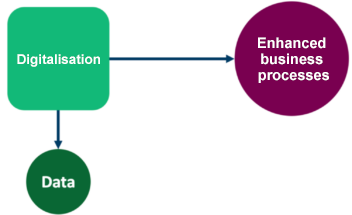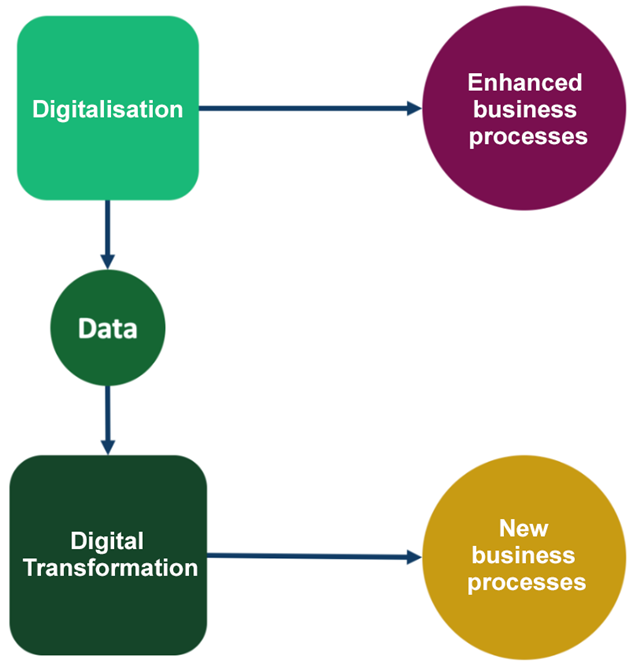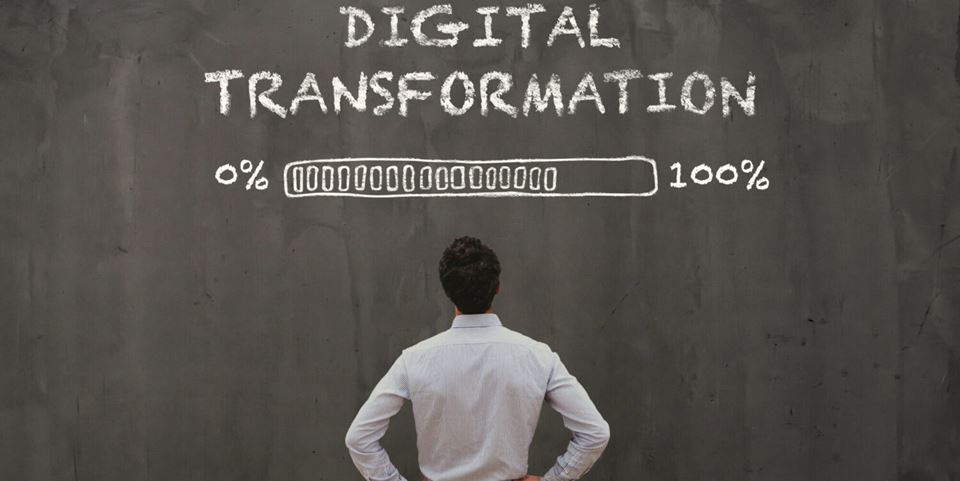Digitalisation addresses the process of delivering the same tasks or products as before, but now with the help of a digital technology. Digitalisation in the banking sector is a good example. Digital transformation, on the other hand, is all about using new digital technologies to enable us to deliver something quite different than what was possible before. In other words, it enables a business to undergo change, or a transformation, which means it no longer delivers the same products as before, but something entirely different.
The terms digitalisation and digital transformation have been tossed around and used interchangeably in parliamentary and consultants’ reports, and in the media. In 2017, the World Economic Forum argued that a digital transformation was crucial to profitability in the private and public sectors. We have an intuitive understanding of these terms, but when we ask ourselves exactly what they mean and whether there is a difference between digitalisation and digital transformation, we don’t always know quite what to say.
Our research has shown that definitions of these terms are frequently lacking, and adequate descriptions hard to find. This can lead to misunderstandings among businesses and, in the worst case, erroneous strategic choices because they do not understand the difference. They may invest in a digital transformation when the money would be better spent on digitalisation.
Research at SINTEF is demonstrating how digitalisation and digital transformation are interconnected and that they are impacting on businesses in different ways.
Digitalisation can best be understood as the sum of the actions that a business takes with the aim of improving or modifying its processes by means of task automation. Digitalisation is nothing new. Programmable punch card technology was in use in the early 1700s as part of the automation of weaving looms.
The digitalisation of business processes enables more data to be captured. These data then make it possible for digital technologies such as artificial intelligence (AI) to be used to further improve these processes (see Figure 1).

Figure 1. Data digitalisation.
New data offer the opportunity to create entirely new and as yet unknown means of wealth creation by applying innovation and setting up new areas of business. This process is known as digital transformation.
Netflix started out as a supplier of film DVDs. Each individual disc was sent to the customer in the post. Instead of going to rental firms such as Blockbuster, where customers could search for films, rent them and then return them, they were automatically sent the next DVD on their list as soon as their last one was returned. This ensured that customers always had a new DVD to watch.
Later, instead of sending discs back and forth, Netflix started to stream films directly to its customers. This was effectively a digitalisation of the now outdated process of receiving DVDs in the post.
By automating what were previously manual processes, Netflix were able to obtain access to massive volumes of data about its customers – what they were viewing, for how long they were viewing, what they liked and didn’t like, as well as the scenes or parts of films in which they were most interested.
In the past, Netflix had obtained data sporadically from reference groups and customer surveys. Based on the knowledge that was available in these data about its customers’ preferences, the company began to produce and enhance its own films and TV series. We must not forget that at this time, traditional suppliers such as HBO and Disney were also launching their own streaming services.
Netflix developed from being a digitalised DVD supplier to a TV and film production company creating its own content based on the data it had obtained from its customers. By changing its business model, it used its data to help it develop into a digitally transformed film and TV company. The link between digitalisation and digital transformation is illustrated in Figure 2.

Figure 2. The link between digitalisation and digital transformation.
Netflix completed its digitalisation and digital transformation by developing its own innovative technologies. However, most businesses and organisations use technologies developed by others. What is important here is how a business interacts with those that develop the relevant technologies. Research into technology start-up companies carried out at business developers Iterate has enabled us to follow the progress of a number of such companies that are currently attempting to digitalise various functions in society. These include everything from how to utilise machine learning to detect vessels, and how to better involve users in the development of digitalised systems.
A relevant current example is the digitalisation and digital transformation taking place in our health services. In Norway, people use the online portal helsenorge.no and other services to enable them to arrange appointments, obtain prescriptions and communicate with their doctors. We can also see that work is in progress to digitalise patient treatment.
At SINTEF we have been monitoring the company FlowZone, which is one of the start-up businesses taking part in the aforementioned ‘Iterate’ project. FlowZone has been working both to digitalise and digitally transform the rehabilitation of patients. By working both thoroughly and efficiently with patients and therapists, FlowZone is developing a digitalised rehabilitation system for patients and their therapists. The impact of digitally-supported interaction and monitoring has led to shorter stays in rehabilitation centres and reduced risk of remission.
The digitalisation of rehabilitation plans and the interaction process not only provides data on how patients follow up their plans. It also offers unique data and insights into the treatments themselves and how individual rehabilitations are working. In other words, it digitally transforms the ways in which treatment and rehabilitation are carried out. This in turn enables FlowZone to modify treatments and rehabilitation approaches, supported by the digitalised and close-knit interactions between patients and their therapists. It also delivers the benefit of exploiting technologies that patients are familiar with and already using, such as Apple Watch and Garmin smart watches. In short, both treatment and rehabilitation have become digitally transformed.
Our research has shown that definitions of these terms are frequently lacking, and adequate descriptions hard to find. This can lead to misunderstandings among businesses and, in the worst case, erroneous strategic choices because they do not understand the difference. They may invest in a digital transformation when the money would be better spent on digitalisation.
So, what is most important to you – digitalisation, digital transformation or both? Our research demonstrates that both are important and that they are interlinked. We believe that businesses must find a simultaneous balance in their focus between digitalisation and transformation.

Figure illustrating flow technologies.
Our findings indicate that businesses that succeed in identifying this balance are doing the following: 1) they operate with an organisation that works efficiently, 2) they focus on how to capture and quality assure their data and, not least, 3) they develop technologies that utilise data, such as those that employ artificial intelligence .
Even after 300 years of experience with digitalisation, more research is needed into our contemporary practical, organisational and legal issues. SINTEF is conducting projects such as 10x-Teams, Digital Klasse (Digital Class) and Transformit in its attempt to find the secrets to success.



